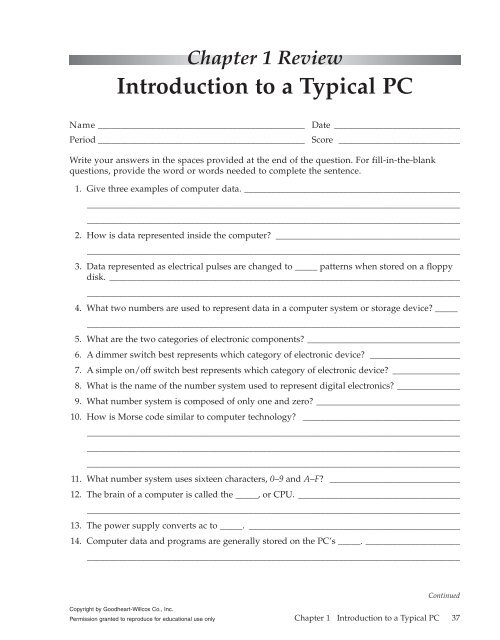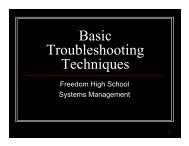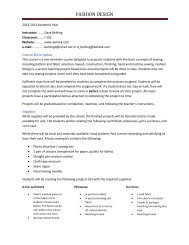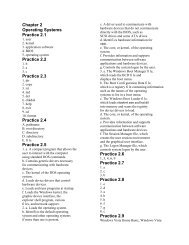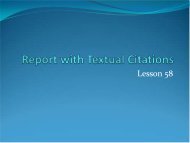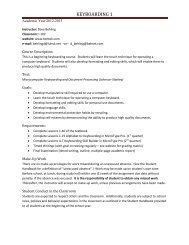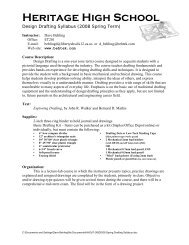Chapter 1 Review Introduction to a Typical PC
Chapter 1 Review Introduction to a Typical PC
Chapter 1 Review Introduction to a Typical PC
- No tags were found...
You also want an ePaper? Increase the reach of your titles
YUMPU automatically turns print PDFs into web optimized ePapers that Google loves.
<strong>Chapter</strong> 1 <strong>Review</strong><strong>Introduction</strong> <strong>to</strong> a <strong>Typical</strong> <strong>PC</strong>Name ______________________________________________Period ______________________________________________Date ____________________________Score ___________________________Write your answers in the spaces provided at the end of the question. For fill-in-the-blankquestions, provide the word or words needed <strong>to</strong> complete the sentence.1. Give three examples of computer data. ______________________________________________________________________________________________________________________________________________________________________________________________________________________2. How is data represented inside the computer? ____________________________________________________________________________________________________________________________3. Data represented as electrical pulses are changed <strong>to</strong> _____ patterns when s<strong>to</strong>red on a floppydisk. _________________________________________________________________________________________________________________________________________________________________4. What two numbers are used <strong>to</strong> represent data in a computer system or s<strong>to</strong>rage device? ________________________________________________________________________________________5. What are the two categories of electronic components? __________________________________6. A dimmer switch best represents which category of electronic device? ____________________7. A simple on/off switch best represents which category of electronic device? _______________8. What is the name of the number system used <strong>to</strong> represent digital electronics? ______________9. What number system is composed of only one and zero? ________________________________10. How is Morse code similar <strong>to</strong> computer technology? ____________________________________________________________________________________________________________________________________________________________________________________________________________________________________________________________________________________________11. What number system uses sixteen characters, 0–9 and A–F? _____________________________12. The brain of a computer is called the _____, or CPU. _______________________________________________________________________________________________________________________13. The power supply converts ac <strong>to</strong> _____. _______________________________________________14. Computer data and programs are generally s<strong>to</strong>red on the <strong>PC</strong>’s _____. ________________________________________________________________________________________________________ContinuedCopyright by Goodheart-Willcox Co., Inc.Permission granted <strong>to</strong> reproduce for educational use only<strong>Chapter</strong> 1 <strong>Introduction</strong> <strong>to</strong> a <strong>Typical</strong> <strong>PC</strong> 37
Name ______________________________________________15. The volatile memory system inside a <strong>PC</strong> case is referred <strong>to</strong> as _____ and is represented by thethree-letter acronym _____. _____________________________________________________________________________________________________________________________________________16. A permanent form of memory is called _____ and is represented by the three-letter acronym_____. _____________________________________________________________________________17. BIOS is a form of _____ memory. _____________________________________________________18. The BIOS supports communication between the _____ and the computer’s _____.___________________________________________________________________________________19. The BIOS s<strong>to</strong>res information about the hardware in the _____.____________________________20. A(n) _____ is used <strong>to</strong> retain data in the CMOS after the computer’s electrical power isswitched off. _______________________________________________________________________21. <strong>PC</strong>I is an example of what? __________________________________________________________22. What is the name and acronym of the test performed by BIOS when a computer is turned on?___________________________________________________________________________________23. A single binary digit is called _____, and a collection of eight binary digits are called a(n) _____.___________________________________________________________________________________24. A(n) _____ is the <strong>to</strong>tal amount of data (in bits or bytes) that a computer can process at one time.___________________________________________________________________________________25. When writing down memory usage, _____ are represented by the letter b, and _____ are representedby the letter B. _____________________________________________________________26. What is the decimal equivalent <strong>to</strong> the hexadecimal letter F? _____________________________27. The first standardized computer symbol code is called _____ and is represented by theacronym _____. _______________________________________________________________________________________________________________________________________________________28. _____ transfer sends data one bit at a time while _____ transfer sends data in many bitssimultaneously. ____________________________________________________________________29. What devices allow computers <strong>to</strong> communicate over telephone lines? _____________________30. Based on the number base 2, how many actual bytes are there in one kilobyte? _____________31. What is the technical term for a “chip”? _______________________________________________32. What is a common source of IC damage? ______________________________________________33. How can ESD be prevented? ____________________________________________________________________________________________________________________________________________34. What generally produces static? ______________________________________________________35. Why should a <strong>PC</strong> technician avoid using magnetic screwdrivers or extraction <strong>to</strong>ols? ___________________________________________________________________________________________38 Computer Service and Repair Instruc<strong>to</strong>r’s ManualCopyright by Goodheart-Willcox Co., Inc.Permission granted <strong>to</strong> reproduce for educational use only


